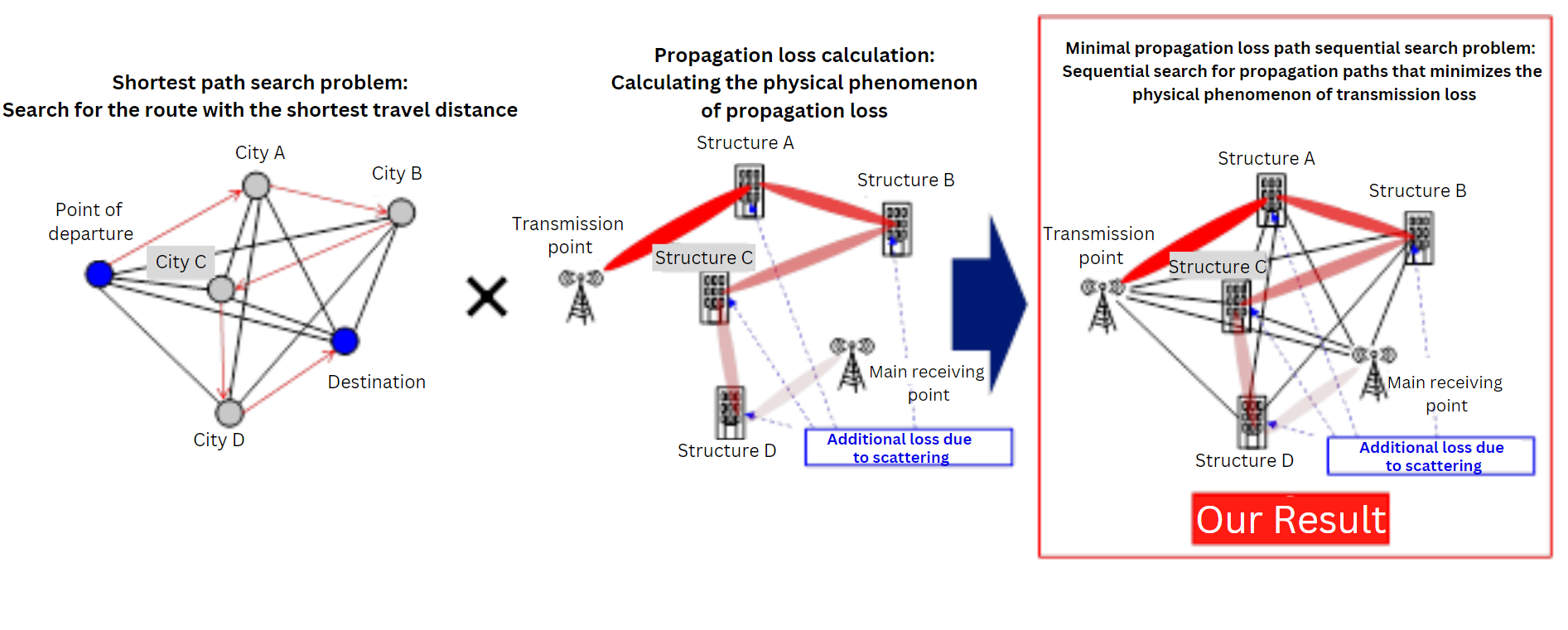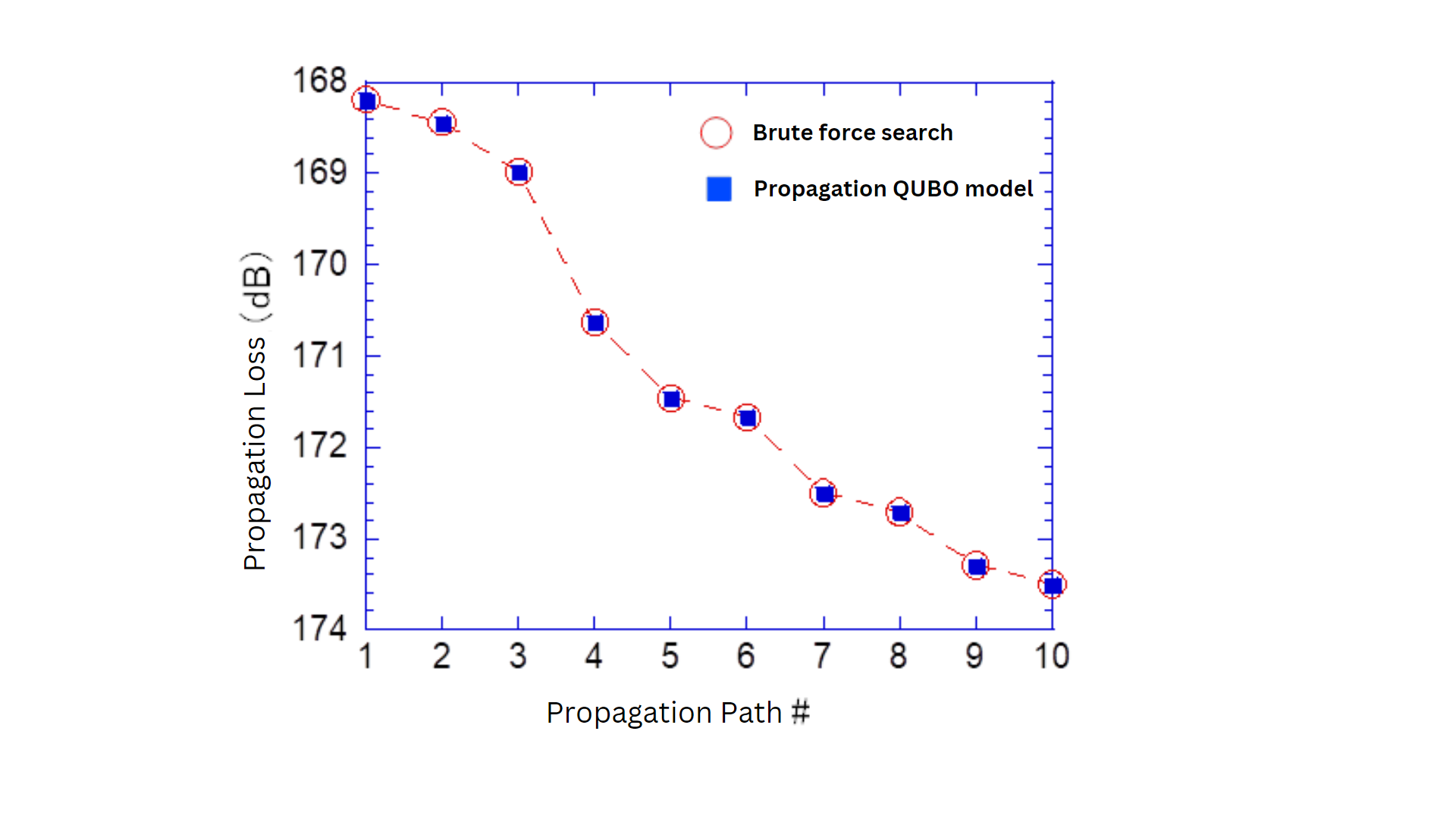Microsoft ends support for Internet Explorer on June 16, 2022.
We recommend using one of the browsers listed below.
- Microsoft Edge(Latest version)
- Mozilla Firefox(Latest version)
- Google Chrome(Latest version)
- Apple Safari(Latest version)
Please contact your browser provider for download and installation instructions.
December 5, 2022
NTT Succeeds in Developing the World's Fastest Wireless Communication Area Estimation Technology
Contributing to the creation of high-quality and natural wireless communication services in the IOWN era
Tokyo — December 14, 2022 — NTT Corporation (President & CEO: Akira Shimada, "NTT") and Tokyo Denki University (Chairperson: Masaaki Ishizuka) have developed a technology enabling the world's fastest radio wave propagation simulation, which is essential for wireless communication area estimation.
Realizing a high-quality wireless environment for the 6G/IOWN era requires further sophistication of base station layout design and control for mobile phones and other devices based on an appropriate understanding of wireless communication areas. With this technology, we were able to estimate the received power at a lower level than before. As a result, we were able to complete radio wave propagation simulation calculations, which previously required over 10,000 years, in less than a second, making it possible to instantly estimate changes in radio wave propagation characteristics due to changes in the environment. This breakthrough is expected to contribute to the realization of stable wireless construction and operation for the 6G/IOWN era, as well as the creation of new services.
NTT proposed and evaluated the concept of this technology, and Tokyo Denki University was in charge of the theoretical design. Details on this technology have been included in GLOBECOM 2022 (Global Communications Conference), a prestigious international conference in the wireless field of the IEEE (Institute of Electrical and Electronics Engineers), to be held in Rio de Janeiro, Brazil from December 4, 2022. The details are scheduled to be announced on December 5th.
Background
To ensure the quality of a radio system, the radio signal must be transmitted from the radio transmitter to the radio receiver at above a certain level as it propagates through space. When there is a direct line-of-sight between the transmitter and receiver, the level of radio waves is high and can be received. However, if there is no direct line-of-sight, the level of radio waves is reduced due to reflection and diffraction.
Therefore, it is important to design and control the wireless communication area based on radio wave propagation to ensure the quality of the wireless system even in places where there is no direct line-of-sight. Furthermore, to maximize the performance of the wireless system, it is essential to understand the noise level of the radio waves received via multiple paths generated in the space from the transmitter to the receiver.
In recent years, the use cases required for wireless systems have expanded to complex environments, such as industrial use cases in which sensors and robots equipped with wireless systems move around while the layout of products changes from moment to moment. Maintaining stable communication quality in each wireless system that connects various devices in a complex environment requires highly accurate radio wave propagation simulation that can quickly respond to changing conditions.
The ray tracing method1, which is widely used around the world as a radio wave propagation simulation method, takes into consideration the reflection and diffraction phenomena of radio waves in electronically modeled structures such as buildings and fixtures. It serves as a technique for calculating path loss that leads to location-specific reception level estimates. The algorithm of the ray tracing method is based on a propagation path search, which is the path along which radio waves fly, including reflection points and diffraction points between transmitting and receiving antennas. In addition to the attenuation of radio waves due to propagation distance, additional losses caused by reflections and diffractions that occur along the path are taken into consideration. In a multipath environment where wireless signals arrive at the receiver through multiple propagation paths, it is necessary to calculate the effects of propagation path search and reflection and diffraction for each propagation path.
In a multipath environment, in addition to radio waves that reach directly from the transmitting antenna to the receiving antenna without going through reflection or diffraction, there are also radio waves that have traveled through multiple propagation paths, such as radio waves that have been reflected multiple times by surrounding structures such as buildings. The propagation loss is the combination of the signals arriving at the receiving antenna. In the ray-tracing method, the propagation paths of these incoming waves are obtained from the combinations of structure surfaces. In general, when the number of surfaces of a structure is 𝑀, the number of candidates for the propagation path with 𝑁 reflections and diffractions is 𝑀(𝑀-1)𝑁-1, and the number of candidates exponentially increases with 𝑁. increases. And since additional loss occurs at each reflection or diffraction, as 𝑁 increases, the number of propagation paths that affect propagation loss decreases among these candidates. Therefore, it has been difficult to quickly find the main propagation path with low propagation loss under the given conditions using the ray tracing method.
Research Results
In recent years, annealing machines2 capable of ultra-high-speed processing for combinatorial optimization problems (such as the shortest path search problem) have already been put to practical use and are attracting attention. Therefore, by combining a propagation loss calculation that accompanies a radio wave route search (such as the ray tracing method with a general shortest route search problem from the starting point to the arrival point via the 𝑁 point), the path that minimizes the propagation loss can be reduced to a sequential search problem and calculated (Fig. 1).
 Fig. 1.Reducing calculations to the sequential search problem for minimal propagation loss paths
Fig. 1.Reducing calculations to the sequential search problem for minimal propagation loss paths
We succeeded in describing radio wave scattering phenomena such as reflection and diffraction, which are basic phenomena of propagation, in the form of QUBO (Quadratic Unconstrained Binary Optimization), which can be executed by an annealing machine. In the general shortest path search problem, the shortest path is searched for, but in the sequential search problem of the minimum propagation loss path, it is necessary to search multiple propagation paths under the same conditions. Another difference is that the route search scale is determined by two factors: the number of structures and the number of scatterings. Therefore, we formulated a constraint condition for searching propagation paths sequentially from the one with the smallest propagation loss and established a technology to describe them in the QUBO format. The establishment of these QUBO models (hereafter referred to as "propagation QUBO models") has made it possible to perform radio wave propagation simulations that operate on annealing machines.
To clarify the effectiveness of the established propagation QUBO model, structures were placed two-dimensionally in a horizontal plane, and operation was verified using the simulated annealing method3. When the results of the brute-force search and the route search by the propagation QUBO model were arranged in descending order of propagation loss, it was confirmed that the two search results matched perfectly, confirming the effectiveness of the propagation QUBO model (Figure 2).
 Fig. 2.Comparison of propagation loss estimation results of propagation QUBO model and brute-force search
Fig. 2.Comparison of propagation loss estimation results of propagation QUBO model and brute-force search
In addition, if the number of structures is 500 and the number of scattering times is 9, the total number of propagation paths is 500×4998 = 1.9×1024. Conventionally, the number of combinations was impossible to calculate in a realistic amount of time, but we were able to confirm that the calculation was completed by applying this model to the simulated annealing method (Fig. 3).
 Fig. 3. Propagation route search example of propagation QUBO model
Fig. 3. Propagation route search example of propagation QUBO model
Future Prospects
As a result of this development, it is possible to estimate the received power at a lower level than before, so it is expected that the allocation of base stations will be further optimized, and power consumption will be reduced. In addition, due to the ultra-high-speed calculation, radio wave propagation simulation calculations, which previously took more than 10,000 years, can now be completed in less than one second. The result is a high-level and highly accurate wireless quality estimation. Since this technology makes it possible to accurately understand the quality of wireless systems in complex environments such as industrial use cases and to dramatically improve stability, it is expected to contribute to the creation of new wireless services in the 6G/IOWN era. In the future, we will continue to improve the algorithm and verify the operation of this model using an actual annealing machine to apply it to new use cases and create new services.
1A method of obtaining radio wave propagation characteristics such as received power by approximately modeling the radio wave propagation path from the transmitting point to the receiving point as a geometric ray
2A type of computer specialized for finding approximate solutions to optimization problems
3A general-purpose approximate solution method for solving optimization problems using probabilistic search
Media Contacts
NTT
Information Network Laboratory Group (PR)
nttrd-pr@ml.ntt.com
Tokyo Denki University
General Affairs, Planning and Public Relations
keiei@jim.dendai.ac.jp
Information is current as of the date of issue of the individual press release.
Please be advised that information may be outdated after that point.
NTT STORY
WEB media that thinks about the future with NTT










